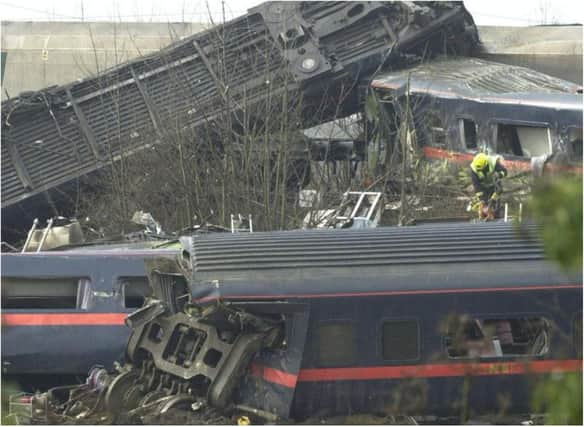Remembering 10 victims of rail tragedy near Doncaster twenty years on


The Selby rail crash, which also became known as the Great Heck rail crash, occurred in quiet countryside, close to the M62 motorway near Whitley Bridge just north of Doncaster on the morning of 28 February 2001.
Ten men were killed and eighty two suffered serious injuries as a sequence of tragic events saw the highest speed railway incident ever in the UK with a closing speed impact of 142 mph.
Advertisement
Hide AdAdvertisement
Hide AdThe crash occurred at approximately 6.13am when a Land Rover towing a car on a trailer, swerved off the M62 motorway just before a bridge over the East Coast Main Line.
The vehicle careered down the embankment coming to rest on the southbound railway track before Gary Neil Hart, the Land Rover driver, tried in vain to reverse his vehicle off the line.
He then climbed from the vehicle and used his mobile telephone to call the emergency services just as the Land Rover was hit by a southbound GNER InterCity 225 travelling at over 120 mph from Newcastle to London King’s Cross and which was en route to Doncaster, where it was due to arrive in a matter of minutes’ time.
After striking the Land Rover, the leading bogie of the 225 derailed but the train stayed upright.
Advertisement
Hide AdAdvertisement
Hide AdHowever, fate then struck a cruel blow and points to nearby sidings deflected it into the path of an oncoming Freightliner freight train travelling from Immingham to Ferrybridge hauled by a Class 66 locomotive.
The two trains collided about half a mile from the impact with the Land Rover.
Most of the 225 coaches overturned before coming to rest down an embankment to the east side of the track. The trailing locomotive, though derailed, remained upright and suffered minor damage.
Both train drivers, two additional train crew on board the InterCity 225 and six passengers were killed.
Advertisement
Hide AdAdvertisement
Hide AdThe coaches of the InterCity 225 were carrying 99 passengers along with train staff.
The outcome, as dreadful as it was, could have so much worse if the train had been closer to its total seated capacity of 544 passengers, with the early morning departure from Newcastle resulting in reduced passenger numbers.
As it was, 45 of the 52 seriously injured passengers and all eight fatalities (excluding the two train drivers) were travelling in the first five coaches, which included a restaurant car and two first class coaches with less densely packed seating than standard coaches.
Gary Hart escaped the collision unscathed and claimed that his car had suffered a mechanical fault, or had collided with an object on the road. and had not applied the brakes as it went down the embankment.
Advertisement
Hide AdAdvertisement
Hide AdHart was tried on ten counts of causing death by dangerous driving, found guilty and sentenced to five years’ imprisonment but released after serving half his sentence.
The ten people who died
Chris Terry, 30, York
Ray Robson, 43, Whitley Bay, GNER conductor
Paul Taylor, 42, Newcastle, GNER chef
Professor Steve Baldwin, 39, York
John Weddle, 47, Newcastle, GNER driver
Stephen Dunn, 39, Selby, Freightliner driver
Alan Ensor, 44, York
Barry Needham, 40, York
Clive Vidgen, 39, York.
Robert Shakespeare, 43, East Yorkshire